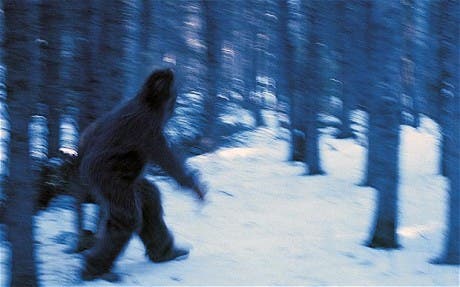One of the most popular urban myths speaks of Bigfoot – an 8-foot tall creature, covered in thick, dark hair. The creature, also known as sasquatch or Yeti (the Asian counterpart) has spurred the imagination of countless people, some of whom went a step farther to report actual sightings of the elusive beast. If you haven’t been living under a rock this whole time, chances have it you’ve seen at least one media report presenting footage that once and for all proves Bigfoot is real. Unfortunately, it seems the footage is always blurry, resembles some other animals or is inconclusive for whatever reason. Tired of these sort of claims or simply bored (perhaps both), a group of scientists have for the first time performed a systematic genetic screening of samples allegedly belonging to Bigfoot or Yeti. Their results show the samples come from all sorts of extant animals: bear, raccoon, horse, cow, sheep, canine, deer and many other.
The internet is riddled with reports and stories of Bigfoot, all complete with evidence of some sort ranging from eyewitness reports, to video material, to footprints. While some of this evidence is genuinely unaccounted for, mainstream science is far from convinced and has instead chosen to class this kind of sightings as those following “anomalous primates”.
An University of Oxford initiative that first began in 2012, called the Oxford-Lausanne Collateral Hominid Project, gathered over 30 organic samples of alleged anomalous primates and analyzed them using most scrutinous DNA sequencing techniques.
“The search for anomalous primates is, in principle, no different from the search for other species unknown to science, and is susceptible to the same recently developed discovery techniques based on DNA barcoding,” says paleontologist and evolutionary biologist Norman MacLeod at the Natural History Museum in London, who did not participate in the study.
The results were recently published in the journal Proceedings of the Royal Society B. As one might imagine, there were no samples whose DNA didn’t matched some kind of known mammalian species. Actually, most of the samples originated from common animals like dogs or bears, even humans, but not Neanderthals as some claims might have had it. The most interesting find was that two of the samples attributed to the Himalayan “yeti” matched DNA from a fossil of a more than 40,000-year-old polar bear (Ursus maritimus). The researchers suggest these hairs might come from a previously unrecognized bear species or, most likely, from a brown-polar bear hybrid.
So, now what’s next? The results first and foremost provide a setting for disputing future claims such as these, so that people wont get so much bombarded with nonsense in the future. Secondly, the study doesn’t actually proves that Bigfoot doesn’t exist. It’s maybe the case that the wrong samples happened to be under investigation. No doubt, future projects such as this will appear, but at a $2,000 price tag per sample, it’s difficult to imagine who will fund anything like this.
“The techniques described here put an end to decades of ambiguity about species identification of anomalous primate samples and set a rigorous standard against which to judge any future claims,” the researchers write in their paper.










